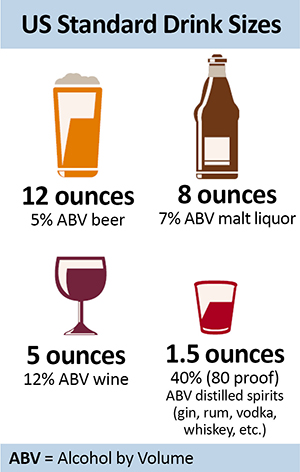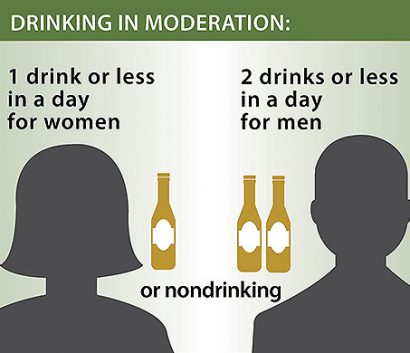Alcohol Use and Your Health
What is a Standard Drink?

A standard drink contains 0.6 ounces of alcohol. Examples of a standard drink include:
- A 12-oz beer (5% ABV)
- An 8-oz malt liquor (7% ABV)
- A 5-oz glass of wine (12% ABV)
- A 1.5-oz shot of liquor (40% ABV)
A mixed drink from a restaurant or bar may include more than one shot of liquor and therefore is more than one standard drink. Cans of beer and seltzer often are in pint-size cans, which are also more than one standard drink.

Moderate vs Excessive Drinking
If you choose to drink alcohol, it is recommended to drink in moderation. Moderate drinking is limiting the number of alcoholic drinks you have each day. Moderate drinking for women is one drink or less a day, and for men is two drinks or fewer a day.
Excessive drinking includes heavy drinking and binge drinking. Heavy drinking is when a woman drinks 8 or more drinks per week, or when a man drinks 15 or more drinks per week.
Binge drinking is when blood alcohol concentration (BAC) is 0.08 or higher. A BAC of 0.08 typically happens when women drink 4 or more drinks, and when men drink 5 or more drinks on a single occasion. Binge drinking is common in the United States, but has many health and safety risks.
Health Risks of Binge Drinking
Short-term health risks include:
- Injuries from car crashes, falls, and other accidents
- Violence, such as homicide, suicide, sexual assault, and intimate partner violence
- Risky sexual behaviors, such as unprotected sex or sex with multiple partners, unintended pregnancy, and sexually transmitted infections
- Death from drowning, alcohol poisoning, or choking on your own vomit while passed out
Long-term health risks include:
- Learning and memory problems, such worsening work and school performance or dementia
- Mental health problems such as depression and anxiety
- Social problems, including problems at work, school, or with family and friends
- Development of cancer of the breast, mouth, throat, esophagus, liver, and colon
- Alcohol dependence or alcohol use disorder
*CDC Alcohol & Public Health: Drinking too much alcohol can harm your health. Learn the facts | CDC
Alcohol Poisoning
Alcohol poisoning is an emergency and can be deadly. Alcohol poisoning can happen when someone drinks a lot of alcohol in a short time.
Signs of alcohol poisoning include:
- Mental confusion
- Difficulty remaining conscious or not being able to wake them
- Vomiting
- Seizures
- Slow or irregular breathing
- Slow heart rate
- Clammy, pale, or bluish skin
- Dulled responses, such as no gag reflex (which prevents choking)
- Extremely low body temperature
Someone with alcohol poisoning to choke on their vomit, so you need to keep them sitting up or lying on their side.
Idaho has a Good Samaritan law that protects you if you call for help for someone experiencing alcohol poisoning or a drug overdose, even if you are underage. Always call for help if you think someone has alcohol poisoning.
Getting Help
Excessive drinking is preventable. If you, or someone you know, drinks excessively or has alcohol use disorder, you can get help. Contact your health care provider to find out if you or someone you know may have an alcohol use disorder. You can also call the National Drug and Alcohol Treatment and Referral Routing Service at 1-800-662-4357. Additional resources are available on the side of this webpage.